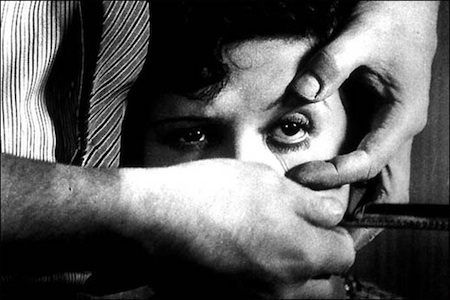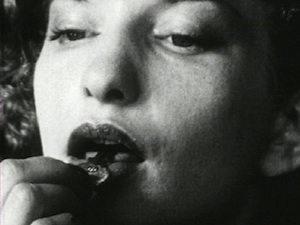When the 2012 Sight & Sound Critic’s Poll was released in stages these past few weeks, the online reaction centered on Alfred Hitchcock’s Vertigo knocking Citizen Kane from the top spot after a 50-year reign at #1. Looking at the full 250-film list, though, the crowning of a new heavyweight champion of cinema is emblematic of what looks to be a sea change (discussed in depth by David Hudson, Kevin B. Lee and others) in the selection process: an injection of new voices into the vote. Nowhere is this more apparent than in a welcome amount of avant-garde films, and those quite visibly influenced by the world of experimental cinema, making the final cut.
Some of the selections—the surrealist visions of Luis Buñuel, Maya Deren‘s masterpiece Meshes of the Afternoon, two works by the recently passed Chris Marker—were expected, having long been regarded as classics of the avant-garde. The more commercial fare created by directors who eschew traditional storytelling methods for more expressionistic films (David Lynch, Lars von Trier, Terrence Malick) also could have been predicted.
But delightful outliers pop up throughout the 2012 poll. Andy Warhol’s stunning split-screen experiment Chelsea Girls is one of 32 films tied for 202nd place. Higher on the list is Michael Snow’s Wavelength, a 1967 structuralist short that Manny Farber said “could become The Birth of a Nation in underground films;” it tied for 102nd with seven others.
Fandor has a number of the films from the Sight & Sound list streaming right now, including Earth, The Turin Horse, Sherlock Jr., Metropolis, The General, Intolerance, A Trip to the Moon, Nosferatu and The Last Laugh. But what follows is a handful of films from the avant-garde end of the S&S spectrum available on Fandor.
1. The Cabinet of Dr. Caligari (1920, Robert Wiene)
This early silent film—pure German expressionism, its abstract sets and angular backdrops framing a truly terrifying story of homicides, insanity and somnambulism —has influenced the avant-garde mightily in this past century. And its narrative techniques, including the big twist ending, serve as a great reminder to screenwriters and directors of all genres to never be afraid to keep an audience guessing.
2. Un chien andalou (1929, Luis Buñuel)
Perhaps the most famous short film ever made, this collaboration between surrealist painter Salvador Dali and first-time director Buñuel starts off with a shot you can’t forget: A man brandishing a straight razor slices a woman’s eyeball open. Of course, it wasn’t really the woman’s eye, but it sets a tone of unease that runs throughout this 16-minute silent. Disconnected images and motifs tumble forth, poking at religious and sexual mores, driven by a sly, subversive wit.
3. Man with a Movie Camera (1929, Dziga Vertov)
This dizzying silent epic, which came in at #8 on the Sight & Sound list, foreshadowed rapid-fire editing and visual tricks that are now filmmaking staples. The spellbinding hour of image and incident pays homage to Soviet life in the ’20s. Modern life is in full flower with shots of trains and streetcars rumbling along, masses of pedestrians pushing past one another and the never-ending pulse of industry. There are also some poetic moments of leisure as sporting events are rendered in slow motion for maximum effect. Vertov expresses his love for the idea that power and emotion can be made so large-scale and impactful by something as simple as moving images.
4. L’Age d’Or (1930, Luis Buñuel)
The first feature by Buñuel was conceived with Dali, but a falling out prior to film left the director to his own devices. This early effort set in motion themes that would be prevalent in Buñuel’s later work, in particular the stifling of one’s desires by society at large. In this case, it is the sexual urges of a young couple unable to consummate their relationship due to the intrusion of their family members, church leaders and the bourgeoisie. It’s a devastating work of art, tinged with greater sadness when you remember the delicious irony in the film’s title, which translates to “The Golden Age.”
5. Meshes of the Afternoon (1943, Maya Deren and Alexander Hammid)
The dream-like logic of Deren’s first short subject can be somewhat difficult to parse. The delicate plot spins out in ever-expanding circles as a woman enters and re-enters a house meeting herself again and again. But like the best experimental film, it’s indelible images within that have kept bringing viewers back to this strangely beautiful work for almost 70 years: the main character (played by Deren) looking through a window; the slow removal of a key from her mouth; reality breaking to reveal a vast ocean lying behind it; and the film’s shocking final shot.





